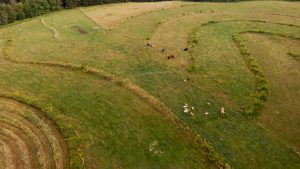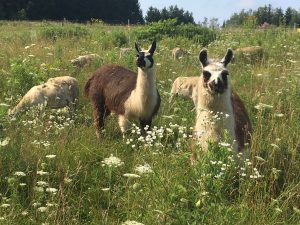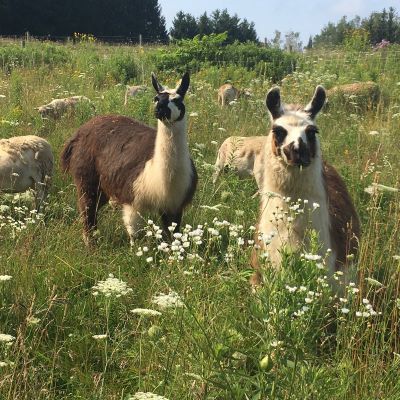Val Steinmann and her family are the stewards of Heartwood Farm, in Erin, Ontario. Since 2004, Val has been immersed in the journey to co-create an ecological farm that is committed to supporting biodiversity and regeneration. Heartwood produces hard and “soft” cider, maple syrup, grass-fed meats, and community.
Q: Tell us about Heartwood Farm’s recent forays into silvopasture. How did you get started? What have you undertaken so far?
We started with managed grazing on a field with erosion patterns that are typical on rolling hills after being used for cash crops. To remediate that pasture we converted it from a cornfield to pasture and hay and began doing managed grazing. We decided to try working with the contour using a keyline system approach, inspired by Mark Shepard. We were inspired by the idea of increasing biodiversity, so as a natural extension of that we began planting fruit and nut trees and native species into that keyline system to mimic natural savannah. That was our first real foray into the potential for silvopasture to increase the diversity of things we could grow on the same acreage, and into learning about all of the ecological benefits to integrating livestock, grassland, and woody perennials.
 More recently I was so inspired by Steve Gabriel’s workshop at the 2020 EFAO conference. I bought his book and read it cover to cover, and realized there were opportunities on our 40 acres to work with land that was neither ecologically nor agriculturally productive, and that we could actually improve the possibilities for both through silvopasture.
More recently I was so inspired by Steve Gabriel’s workshop at the 2020 EFAO conference. I bought his book and read it cover to cover, and realized there were opportunities on our 40 acres to work with land that was neither ecologically nor agriculturally productive, and that we could actually improve the possibilities for both through silvopasture.
I had worked with goats before and was really intrigued with how I might work with sheep to get that nice combination of grazing and browsing in a smaller animal. I spent a fair bit of time over the winter researching breeds and where to buy them. This small farm has a lot of wildlife corridors and thus a plethora of predators. Before we could bring small ruminants back to the farm, we needed to figure out which livestock guardians to choose. A dog wouldn’t work with the farmstay programming we wanted to start, so we chose llamas. They are one of the three livestock guardian animals known to protect sheep and goats; dogs are the second and donkeys are the third. Llamas are fairly ideal in this situation- they eat the same things as sheep, they’re quieter, and they’re fairly easy keepers.
This winter, a friend and I cleared a path for some fencing in the hedgerow adjacent to our pasture to be able to practice and observe how the sheep and llamas interact with this environment, which has been really helpful. I love watching them out there- they eat the goldenrod, wild grape, they strip the burdock right down and eat Norway maple. They’re opening it up a bit, and now I think I can seed the understory to get some better forages growing there.
Q: How did the 2020 conference inspire you to explore silvopasture? What learnings from last year’s conference have you been able to apply in practice?
Steve Gabriel’s work was really inspiring because I realized how similar our little farm is to his farm. There were some similarities that I had never realized had so much potential. With this realization, areas on our farm that we hadn’t paid much attention to – areas of old pine plantation that had been left to naturalize- were suddenly of interest. I was inspired to spend time over the winter walking those zones and getting familiar with them and letting the ideas from Steve’s talk and his book percolate. There were a few silvopasture meetups afterwards as well, and it was inspiring to hear other people talking about these ideas.
I also realized that in order to begin this journey of remediating old plantations, I would need the help of a forester to do some thinning. I hired Pam Jackson, EFAO member and part of the Erin Soil Health Coalition, to help me. She is trained as a forester and has interest in developing pasture-based systems on her family’s farm. She understands how forestry is a part of protecting the natural landscape, and she’s also willing to imagine that we could learn to think differently about forestry management as a way to benefit both the natural environment and agricultural productivity.
I also reached out to Naresh Thevathasan, who is an incredibly warm, generous, and engaged academic at the University of Guelph. He has done a lot of work in other parts of the world with farmers and agroforestry. He was so willing to listen to my ideas, and has offered to connect me with some students to do research projects on the land and supply some cover crop seeds. He also offered some seedlings from agroforestry plots that are being removed after the land was sold.
Q: What challenges have come up so far? What benefits (in land, livestock, etc) have you seen so far on your farm? What has been your biggest challenge in implementing silvopasture?
The biggest challenge so far is the financial one. There are significant costs associated with silvopasture, such as buying livestock, fencing, etc., and it’s hard to make a business case for doing this work. I do think regenerative agriculture is a call to remediate or heal the land, and that is work that requires investments of time and energy that is not necessarily all about immediate return on investment. Restoring land that has been degraded is a public good, a collective benefit. I’m considering creative ways of asking the broader community to support that work. It’s hard to think about going to the community to ask for help with this land remediation project. I’ve been inspired to see other farms doing this kind of thing. For example, Topsy Farm on Amherst Island put out to their community an invitation to buy a foot of hedgerow.
 Working with a different species and learning how to use electronet fence and other kinds of portable electric fencing in a messy woodland zone rather than a pasture is a challenge. I do worry about predators, even with the llamas. I’m concerned about the ease of some predators getting at the sheep that are amongst trees and hedges, which is a more problematic zone to keep livestock than pasture. Another challenge has been adding another species that needs separate fencing. If I can find a way for the majority of the season to keep the sheep grazing in the original silvopasture zone with the cattle, that would solve this issue. Initially the cattle were really weirded out by the llamas and I couldn’t keep them together!
Working with a different species and learning how to use electronet fence and other kinds of portable electric fencing in a messy woodland zone rather than a pasture is a challenge. I do worry about predators, even with the llamas. I’m concerned about the ease of some predators getting at the sheep that are amongst trees and hedges, which is a more problematic zone to keep livestock than pasture. Another challenge has been adding another species that needs separate fencing. If I can find a way for the majority of the season to keep the sheep grazing in the original silvopasture zone with the cattle, that would solve this issue. Initially the cattle were really weirded out by the llamas and I couldn’t keep them together!
Another challenge is getting good at any one thing with such complex systems. Complexity and diversity inspire me and energize me. My philosophy is if we can set something in motion and not micromanage it, maybe we can trust that ecological principles will guide it and do some of the work, and we can get out of the way. However sometimes this means that things are set in motion and aren’t always completed.
As far as benefits I’m really intrigued to see the impact that the sheep have, such as opening up a tangle of hedgerow overgrowth. I’m still too new at this to be able to discern whether that impact is exactly what it should be, but I like what I’m seeing with the sheep. They really put on good condition over the summer, despite the heat and humidity. I think they really benefited from a cooler, shadier environment during the hottest parts of the summer. I’m observing that they’re eating things we would normally consider to be problems or weeds.
Q: Have you found any suppliers, especially for trees, that have worked well for you?
We’ve purchased trees through a few nurseries, both here in Ontario and we’ve imported some through collaborations with other farmers. We’ve used a real patchwork of sourcing, as we’ve heard about opportunities. There are a couple of nurseries in the East that have some university support to select the best native blight resistant hazelnuts – so we imported 300 native hybrid hazelnut seedlings from them.
Whiffletree has been a good source for some things early on. We’ve started to do more of our own propagating and grafting onto rootstock as it’s more cost effective. Our strategy has been to plant many cheaper plants and see what survives. We’ve transplanted native species that grow on our farm. In our keyline system, we have 4400 linear feet of hedgerow, half of that planted with fruit and nut trees we sourced, and half planted with GRCA trees from Green Legacy.
Q: What has been your greatest learning so far?
The big aha for me was recognizing that on our particular farm, there are naturalized zones that we don’t traditionally think of as farmland, but that are also not thriving. I’ve learned that many parts of the farm are disturbed sites so they’re not in their natural, vital state. They’ve been disturbed by humans, and they’re languishing. I realized that there are approaches and resources and inspiring models to work with these areas that I may have turned a blind eye to in the past. I just hadn’t previously fathomed how they might benefit from some human intervention, and could even be brought under the umbrella of agricultural production.
The part that’s captured my imagination is the area of overlap in the tension between agricultural productivity and a conservation ethic: How can we be feeding our community in ways that actually support biodiversity and remediation for the landscape? I think that’s a really hopeful area for farming, and it requires some different thinking from all sides. It’s very hopeful, how much potential there is to develop a deeper knowledge of the intersection between ecological and agricultural knowledge and productivity. Rather than seeing them as different paths on different parcels of land, maybe we can see the increase in both of those things as having greater potential than we’d once imagined.

For example, Pam was curious to know if the tree bylaw officer would allow her to put in a prescription for a logging plan on our farm that would identify the use of sheep as a site prep strategy for planting an oak savannah. That’s not a typical strategy, but it’s much more appealing than using Roundup to kill the invasives and clear the land.
Q: What questions and areas of future learning have been coming up for you as you undertake these projects?
These silvopasture approaches may have implications for how we eat in the future. I wonder if there are foods we could introduce into our diets that would create a new market and a potential revenue stream for a small farm using silvopasture practices.This would mean we could make use of important zones on our farm without upsetting the ecological balance.
Another thing that I’d like to learn more about is coppicing and pollarding, which are different styles of cutting the tree above grazing height at the appropriate spot so that the tree sprouts lots of new growth. From there you can chop and drop the growth for livestock fodder. I tried some of these techniques out this spring but I don’t really know what I’m doing and I have a lot to learn. Similarly, I’m interested in learning to make tree hay to reduce feed costs.
I would love more opportunities to learn a bit more locally and experientially about silvopasture.
Q: What is your silvopasture vision for Heartwood Farm?
One part of the vision is to try another new project in a part of the farm that has been more neglected, and to see what comes of that in the form of learning and collaboration. I’m interested in the possibilities of collaborating on research and other projects, whether that’s through farmer-led research, with the UofG, or with others. I’m interested in being able to observe, monitor, and collect data. Different partnerships have already brought in more expertise and perspectives to our farm and we’d like to build on that. I would like to find a way to document and monitor where we’re starting from and where we hope to get to and what the experience is along the way, especially in terms of using silvopasture to remediate old plantations. I want to be able to tell the story of this remediation in a more detailed way than I can on my own. For example, how do we monitor and measure biodiversity increases? How well do the sheep and lambs do in this setting? What kind of soil improvements can we make in an old plantation? Can we establish a more vital oak savannah in a spot where we now have dying Scots pine? Can the forestry prescription that land owners can access be expanded to encourage land use that has ecological benefits as well as agricultural benefits?
My vision also includes inviting the non-farmer community to see what we’re doing here and to share the story of silvopasture on our farm. People are fascinated with learning from the keyline system, how we move the cattle twice a day to mimic bison, and the diversity in the hedgerows. We charge for those tours, and that’s definitely part of my vision, that there could be some revenue within sharing that ecological knowledge.

